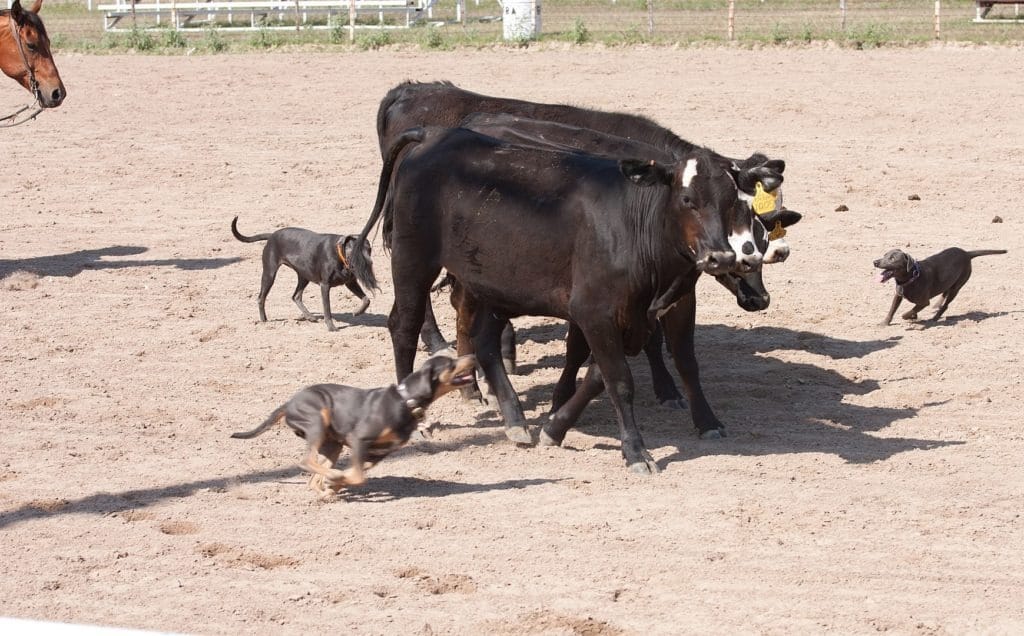Blue Lacy Dog
Canis lupus
Originated in Texas in the mid 1800s!
Advertisement
Blue Lacy Dog Scientific Classification
- Kingdom
- Animalia
- Phylum
- Chordata
- Class
- Mammalia
- Order
- Carnivora
- Family
- Canidae
- Genus
- Canis
- Scientific Name
- Canis lupus
Read our Complete Guide to Classification of Animals.
Blue Lacy Dog Conservation Status
Blue Lacy Dog Facts
- Temperament
- Intelligent, active and alert
- Training
- Should be trained from an early age as they can become dominant
- Diet
- Omnivore
- Average Litter Size
- 5
Blue Lacy Dog as a Pet:
- General Health
- Energy Level
- Shedability
- Trainability
- Intelligence
- Tendency to Chew
- Size
- Family and kid friendliness
- Yappiness / Barking
- Moderate
- Separation Anxiety
- Moderate
- Preferred Temperature
- Warm climate
- Exercise Needs
- High
- Friendly With Other Dogs
- Moderate
- Pure bred cost to own
- $600
- Dog group
- Working
- Male weight
- 35-55 lbs
- Female weight
- 25-45 lbs
This post may contain affiliate links to our partners like Chewy, Amazon, and others. Purchasing through these helps us further the A-Z Animals mission to educate about the world's species.
View all of the Blue Lacy Dog images!
The Blue Lacy Dog is the official dog breed of Texas by the state’s legislature.
As a Texas native, it’s no surprise that the Blue Lacy is most popular in this southern US state. While the breed, which is also known as the Lacy Dog, isn’t currently recognized by major kennel clubs, it has been accepted as the official dog breed of Texas by the state’s legislature. Despite their reputation as athletic working animals, they are also typically family-friendly and are a good fit for households with children. They respond well to verbal commands and have been used to manage animals on farms and ranches since their introduction in the mid-1800s.
See all of our expert product reviews.
Despite its low international profile, the Blue Lacy breed has slowly been spreading outside its native state due to its friendly, obedient, and energetic nature. Their short and often uniquely-colored hair lends them an interesting aesthetic with relatively little maintenance required.
3 Pros and Cons of Owning a Blue Lacy Dog
| Pros! | Cons! |
|---|---|
| Easy to Train Lacy Dogs were bred to herd, drive and hunt, so they are very receptive to training and interaction with humans. They are typically obedient and responsive by nature, so owners rarely struggle to instill basic commands and desirable behaviors. | Craves Exercise As dedicated working dogs, owners should fully expect to provide ample exercise to their Blue Lacy. These animals can spend hours upon hours running around and assisting in physically demanding outdoor activities, so they need opportunities to get their energy out. |
| Observant and Intelligent The breed is also known for its observation and intelligence, which are both necessary for the complex activities it was bred for. This means owners don’t need to worry so much about their pet running out into the road or making other silly blunders, although it’s still a good idea to keep your eye on your canine whenever possible. | Prefers Open Space As you may expect, their high energy level and desire for participation in activity mean they are better suited for open spaces. Small yards with little open space or opportunity for ranging aren’t ideal for the breed. |
| Sleek and Clean Coat Another big advantage of this breed is its low-maintenance coat. Their short, sleek hair requires minimal brushing or grooming compared to many of the other dog breeds out there. They also have good personal hygiene habits. | Sensitive to Scolding Lacy Dogs are very owner-oriented, which means they can be overly sensitive to verbal scolding. Soft and stern commands are preferred. Yelling can be demoralizing and frightening for the animals, even if it isn’t directed at them. |
History and Origins
The breed is named after the Lacy family, who traveled from Kentucky to Marble Falls, Texas, in a covered wagon in 1858. From that time, the Blue Lacy Game Dog has been an essential part of life on ranches in the US Southwest for over a hundred years, living up to the image of a true pioneer.
When the three-wheeled ATV was first developed, it almost caused the total disappearance of the Blue Lacy Dog breed. Even though its herding skills were becoming less important, its ability to track down and hunt wild hogs or find wounded prey using its acute sense of smell was being utilized more and more in the commercial hunting world.
The Blue Lacy dog is described by its owners as being an all-around ideal pet, having the knack for being in the right place at the right time. The Lacy family claims that the breed is a mix of scent hound and coyote and was bred to possess herding and droving abilities. There are many theories as to what type of scent hound was used, with some speculating that it was either a Red Bone Hound or an Italian Greyhound, while others suggest it was a July Hound. Whatever hound was bred in, the combination worked, and the Lacy brothers established the standards for the breed.

Blue Lacy dogs were bred as herding and scenting dogs.
Health and Entertainment for your Blue Lacy Dog
See all of our expert product reviews.
©Jessica Lobsinger/Shutterstock.com
Size and Weight
Lacy Dogs have balanced and athletic frames, so their weight is ideally distributed into muscle with little fat. Their target adult weight ranges between 25 and 50 pounds, with a typical height of 18 to 24 inches.
| Male | Female | |
|---|---|---|
| Height | 22’ Tall | 20’ Tall |
| Weight | 45lbs, fully grown | 35lbs, fully grown |
Common Health Issues
Compared to many other modern breeds, the Blue Lacy is remarkably healthy and does not have any major health issues associated with its heritage. As a working breed with a stable genetic pool, emerging health issues are typically discovered quickly and aren’t passed down into future generations. The breed’s hardy reputation does not guarantee freedom from medical issues and there are a few common issues that owners may face.
The distinct blue color of the coat of some Lacy Dogs is associated with some types of skin problems, including demodex mange, allergies and other causes of patchy hair loss. It’s also important to note that sensitivity to anesthesia is a recognized and serious problem in Blue Lacy Dogs. Skeletal and vision issues can also emerge in these dogs, although they are relatively rare.

Blue Lacy dogs have few health problems.
©TrueBlueLacys, CC BY-SA 3.0, via Wikimedia Commons – License
Temperament
Lacy Dogs have a strong personality that is characterized by a strong motivation to perform, participate and please their owners. Their ability to be quickly trained is one of their hallmark traits that earns them a reputation as fantastic working animals. They also exemplify loyalty, diligence and alert behavior, so they are desired as watch dogs for property or family protection.
Despite their energetic and ambitious personality, the Blue Lacy can also be unusually sensitive to discipline. This temperament means that they tend to react poorly to yelling and other forms of social or physical punishment that other dogs would shrug off. While the breed is relatively calm and suited towards people, they aren’t known for being particularly friendly to strange people or animals in the home.

Blue Lacy dogs have strong personalities.
©Rainbowbrooke – Public Domain – License
How To Take Care of a Blue Lacy Dog
Maintaining activity is the biggest consideration for owners, since the breed is very exercise and work-oriented compared to most pets. If herding animals or chasing game isn’t an option, it’s a good idea to provide ample opportunities for outdoor excursions that test endurance and agility. Puppies should receive plenty of encouragement, socialization and training as soon as they enter the household.
The Best Dog Food
Blue Lacy Dogs don’t have any particular or pressing dietary requirements. Managing food intake and nutrition is best done with the assistance of a veterinary professional, especially if owners prefer to give their pet homemade meals. If your Blue Lacy experiences allergies, look into the selection of allergy-friendly dog food.
Blue Lacy puppy food: Lacy Dog puppies wean onto wet and solid food at about the same rate as other breeds. Balanced nutrition with portions according to weight and age are find. Natural, vet-approved supplements that encourage bone strength can be an asset for animals that are destined as assistants in herding or game pursuits.
Blue Lacy adult dog food: Feeding an adult Lacy dog can be a bit more of a challenge due to their high activity levels. Adults should always have access to clean water at all times, especially when they spend a lot of time outdoors performing high-energy exercise. Their food intake should also reflect exercise levels, with balanced nutrition, protein, and enough calories to maintain their activities.
The A-Z Animals pick for the best Blue Lacy dog food is Purina Beyond Simply, Natural Chicken Adult Dry Dog Food.
This limited ingredient recipe removes allergy-causing additives corn, wheat, soy, and other fillers. It’s protein-rich for muscle building and joint/skeletal support. Additionally, omega 6 fatty acids promote healthy, itch-free skin and silky fur. The probiotics will optimize your Blue Lacy’s digestion, too.
Check Chewy and Amazon for this product.
Maintenance And Grooming
These dogs have a short, smooth and sleek coat that is very easy to maintain. Grooming requirements are minimal, so owners should only expect to do weekly brushing and occasional bathing as needed. While they do go through seasonal shedding cycles, their short fur and lack of undercoat means it isn’t a huge hassle.
Training
Ease of training is a hallmark characteristic of Lacy Dogs and is something every owner should focus on, even if they aren’t using them for game, herding or other work activities. These dogs respond very well to verbal commands given with a stern and soft voice. Harsh words, loud commands and other types of negative reinforcement are not recommended since they can be very discouraging to these dogs.
Exercise
Their limber frame, athletic build and short fur make the Blue Lacy an ideal pick of outdoor activity in warmer climates. Complex, demanding and prolonged exercise sessions are ideal, since the breed was originally meant for day-long work activities. Running, chasing, and fetching are all important components of a fitness regime. They are great companion dogs for sportsman, ranchers and farmers.

Blue Lacy dogs are excellent herders.
©jbolles / CC BY-SA 2.0 – License
Puppies
Blue Lacy Dogs don’t have any special health concerns as puppies. Owners should take care to socialize them early and often to prepare them for life alongside children or other pets. Socializing around other dogs can be particularly important since the breed can struggle to adapt to unfamiliar animals as adults.

Socialize your Blue Lacy early.
©en: user: TrueBlueLacys, CC BY-SA 3.0, via Wikimedia Commons – License
With Children
Despite their reputation as fantastic family dogs, the Blue Lacy does need some special attention when it comes to young kids. They are very energetic and are used to structure, so they may not understand how to react to children unless trained. They are usually loyal and protective of their family though.
Dogs similar to a Blue Lacy Dog
- German Shepherd – German Shepherds share many key characteristics with the Blue Lacy. Both breeds are smart, active, and ideal for working alongside humans. They also share a hesitancy to trust strangers and are fiercely loyal to their owners.
- Australian Cattle Dog – Cattle dogs find their origins as a working dog much like the Lacy. Both are adapted to working environments where they have an active and participatory role in the day’s work.
- English Shepherd – These dogs hailing from the British Isles are another working breed with a similar size and temperament to the Blue Lacy. They are smart and can be trained quickly, but are a bit more assertive and confident around people than Lacy Dogs. They make great companion animals and are also a bit more tolerant of cold weather.

Blue Lacy dogs need to be trained in how to behave around young children.
©Jessica Lobsinger/Shutterstock.com
Popular Names
- Chloe
- Sophie
- Bella
- Magnum
- Bismark
- Saturn
- Sergeant
Blue Lacy Dog FAQs (Frequently Asked Questions)
What is a Blue Lacy dog?
The Blue Lacy is a versatile and energetic breed that was first developed in the southern US state of Texas. While it’s far from the most popular, it has few health problems and plenty of great qualities that make it a solid choice for owners who don’t mind investing time in frequent activity and training exercises.
Are Blue Lacys good family dogs?
Lacy Dogs thrive as outdoor and duty-driven companions, but they can be great pets too as long as they are given opportunities to exercise and acclimate to domestic life. However, families with limited outdoor access, particularly apartments, may want to consider other breeds.
How long do Blue Lacy dogs live?
Lacys have a life expectancy of 14 to 16 years, which is about typical for mid-sized dogs. They have few genetic health concerns, so injury or exposure to natural toxins is a primary hazard compared to many other breeds.
What breeds make a Blue Lacy?
There is some debate about the true origins of the Blue Lacy. The family that originated the breed reportedly crossed Greyhounds with English Shepherds, although some believe that it was coyote and Greyhound instead.
Are Blue Lacy dogs really blue?
Steel-like blue fur is a notable characteristic of some Lacy Dogs, but there is actually variety in color. Aside from the “blues,” there are also “reds” that have an orange or rust color and the “tri” that combines blue, red, and white markings.
How much does Blue Lacy cost to own?
In the United States, Blue Lacy puppies range from $500 to $600 dollars from reputable breeders. Their relatively good health and balanced dietary requirements can balance out maintenance costs, although owners may need to invest in good quality food to avoid fur loss and other skin issues.
Is Blue Lacy good with kids?
Lacy Dogs aren’t the most child-friendly breed out there, but they are good family dogs especially if they are raised around and acclimated to this lifestyle. They can be very energetic and active, so they should always be supervised when around very young kids.
Are Blue Lacy Dogs herbivores, carnivores, or omnivores?
Blue Lacy Dogs are Omnivores, meaning they eat both plants and other animals.
What Kingdom do Blue Lacy Dogs belong to?
Blue Lacy Dogs belong to the Kingdom Animalia.
What class do Blue Lacy Dogs belong to?
Blue Lacy Dogs belong to the class Mammalia.
What phylum to Blue Lacy Dogs belong to?
Blue Lacy Dogs belong to the phylum Chordata.
What family do Blue Lacy Dogs belong to?
Blue Lacy Dogs belong to the family Canidae.
What order do Blue Lacy Dogs belong to?
Blue Lacy Dogs belong to the order Carnivora.
What genus do Blue Lacy Dogs belong to?
Blue Lacy Dogs belong to the genus Canis.
What type of covering do Blue Lacy Dogs have?
Blue Lacy Dogs are covered in Hair.
How many babies do Blue Lacy Dogs have?
The average number of babies a Blue Lacy Dog has is 5.
What is an interesting fact about Blue Lacy Dogs?
Blue Lacy Dogs originated in Texas in the mid 1800s!
What is the scientific name for the Blue Lacy Dog?
The scientific name for the Blue Lacy Dog is Canis lupus.
Thank you for reading! Have some feedback for us? Contact the AZ Animals editorial team.
Sources
- David Burnie, Dorling Kindersley (2011) Animal, The Definitive Visual Guide To The World's Wildlife
- Tom Jackson, Lorenz Books (2007) The World Encyclopedia Of Animals
- David Burnie, Kingfisher (2011) The Kingfisher Animal Encyclopedia
- David Burnie, Dorling Kindersley (2008) Illustrated Encyclopedia Of Animals
- Dorling Kindersley (2006) Dorling Kindersley Encyclopedia Of Animals
- National Kennel Club, Available here: http://www.nationalkennelclub.com/breed-standards/blue-lacy.htm
- Rover, Available here: https://www.rover.com/blog/blue-lacy-texas-state-dog/
- Easy Pet MD, Available here: http://easypetmd.pawsdogdaycare.com/doginfo/blue-lacy
- Wikipedia, Available here: https://en.wikipedia.org/wiki/Blue_Lacy


















